LaToya M. Hobbs: It’s Time
Harvard Art Museums, Boston, MA • harvardartmuseums.org • Through July 21, 2024

featuring LaToya M. Hobbs, Scene 5: The Studio, © LaToya M. Hobbs, 2022.224.5. © President and Fellows of Harvard College.
Rendering a day in the life of an African-American artist and her family is a monumental suite of woodcut prints on display at the Harvard Art Museums. LaToya M. Hobbs: It’s Time is the first public presentation of Carving Out Time (2020–2021), a suite of five woodcut prints by the forty-one-year old, Arkansas-born, Baltimore-based painter and printmaker LaToya M. Hobbs.
Hobbs describes her ensemble as “a visual representation of a day in my life as a mother and practicing artist. With each progressive scene viewers are able to experience moments of my life that I hope are reflections of their own lives.”
In five life-size scenes, Hobbs depicts a day with her pandemic-bound family, husband Ariston Jacks and their two young sons, Ade and Theo. Morning shows the couple being woken by their children. Homeschool and Housework is a view of the family as they work and play. Dinner Time presents the four as they dine together. In Bedtime for the Boys, the parents prepare their children for bed. The fifth and final scene, The Studio, shows Hobbs at an easel surrounded by painting and woodcut projects.
Each scene includes elements of daily life, such as the children’s drawings, toys, and favorite picture books, including Spike Lee and Tonya Lewis Lee’s Please, Baby, Please, as well as images of works by other artists who have influenced Hobbs, among them Elizabeth Catlett, Alma Thomas, and Kerry James Marshall. Her pose in The Studio evokes a 2008 self-portrait by Marshall on view in another gallery, his enormous Afro echoed by her faint halo.
Measuring 60′ in its entirety, Carving Out Time induced a contemplative state in viewers.
“Everybody who has entered the installation has expressed a sense of awe as they encounter this work,” said exhibition organizer Elizabeth M. Rudy, curator of prints at the Harvard Art Museums, speaking by phone. “You can’t take all of it in right away. It takes time to see it. This is partly to do with its scale; but also due to her incredible talent at carving. There is such a variety of textures and such a range of details.”
Noting a 1515 woodcut of similar scale in the Renaissance gallery depicting the Old Testament scene of the Pharoah’s army drowning in the Red Sea, Rudy said, “The history of large prints goes all the way back to the Renaissance, and this work is pushing that long history. And here is an African-American artist portraying herself and her family on a monumental scale.”
Hobbs presents her life and artistic lineage with no less grandeur, and with a marvelous intensity of detail. Her finely carved lines capture the glow of morning light on a bedspread and a glimpse of daylight and trees from windows. Also notable are details that Hobbs leaves out. “Toys on the floor cast shadows, but not completely,” said Rudy. “She knew she didn’t need to do this on this scale, because our eyes would fill in the rest. She’s allowing trust between the viewer and the object she’s created.”
Each 8 x 12′ scene is a triptych comprising three 8 x 4′ cherry plywood panels that interlock to form a single composite image. Starting with stick-figure sketches, Hobbs carved each panel with hand-held tools.
Occupying an entire gallery, the installation includes her preparatory drawings, on display for the first time, and video footage by Jacks, a visual artist, showing Hobbs carving the woodblocks, coating them with black ink, and collaborating with printers to transfer the images from wood onto paper.
Carving Out Time is the largest expression within the artist’s ongoing “Salt of the Earth” project, which celebrates Black women as preservers of family, culture, and community. A professor at the Maryland Institute College of Art, Hobbs is a founding member of Black Women of Print, a digital homeplace fostering an intergenerational community of Black women printmakers and their narratives of Black womanhood.
Carving Out Time exists in two forms—the prints and the print matrix (the twelve wood panels) which Hobbs regards as an art object, not just a production tool. Currently on view at the Frist Art Museum in Nashville, the panels are part of the contemporary art collection of the Baltimore Museum of Art.
“Carving Out Time is a technical marvel on a grand scale,” said Rudy, “and a powerful statement about the capacity of prints to be deeply personal and universal at once. This acquisition was transformative, both for our museums’ holdings of contemporary art and for its representation of monumental prints in the long history of printmaking.”
— Susan Saccoccia
